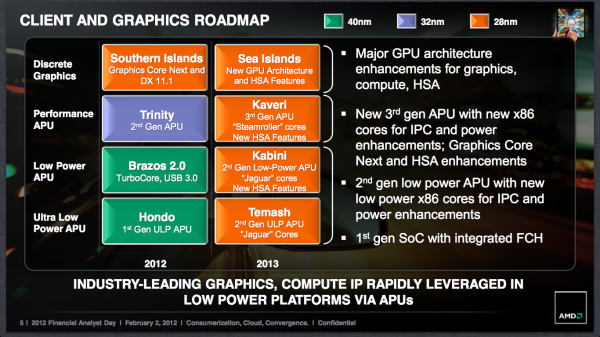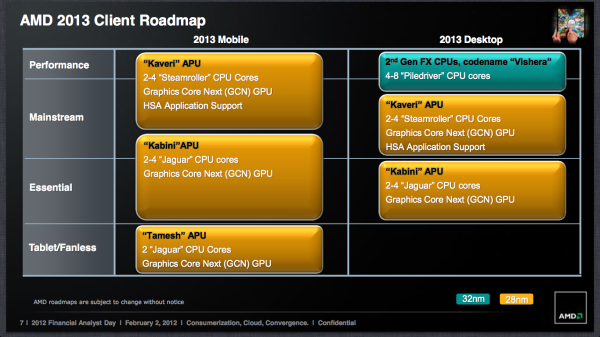Understanding AMD's Roadmap & New Direction
by Anand Lal Shimpi on February 2, 2012 6:16 PM EST- Posted in
- CPUs
- AMD
- Trade Shows
- AMD FAD 2012
We've been providing live coverage of AMD's 2012 Financial Analyst Day from Santa Clara today, but if you want a summary of the company's strategy under new CEO Rory Read you've come to the right place. Below you'll find links to everything we've published from AMD's FAD 2012:
AMD's Rory Read Outlines AMD's Future Strategy
AMD Outlines HSA Roadmap: Unified Memory for CPU/GPU in 2013, HSA GPUs in 2014
AMD is Open to Integrating 3rd Party IP in Future SoCs
AMD's Financial Analyst Day 2012 - Mark Papermaster, SVP & CTO Presentation
AMD: Flexible Around ISA
AMD Nods at Shorter Design Cycles, More Synthesized Designs
What AMD Views as Important: Tablets, Servers, Notebooks & GPUs
AMD & Compal Show Off 18mm Trinity Notebook
AMD's 2012 - 2013 Client CPU/GPU/APU Roadmap Revealed
AMD's 2012 - 2013 Server Roadmap: Abu Dhabi, Seoul & Delhi CPUs
AMD is Ambidextrous, Not Married to Any One Architecture, ARM in the Datacenter?
AMD's Tablet Architectures: Hondo at 4.5W, Future Sub-2W SoC
The name of the game for AMD in 2012 is execution. Far too often at previous AMD events we'd see a roadmap with no indication of whether or not AMD would actually stick to it. Plans were always aggressive and made sense, but execution rarely mirrored what was promised on paper. AMD in turn ended up delivering CPUs sometimes years after they were promised, which obviously didn't help grow the company.
Over the past few months Rory and his new management team at AMD have been restructuring the company to improve execution. As a much smaller company than Intel, AMD had an almost impossible task competing in the x86 space, but AMD should have also been far more agile than it was given its size. AMD's restructuring is supposed to fix these agility and execution problems. The proof will be in how well AMD is able to introduce products over the next 24 months.
As far as the roadmap goes, AMD already laid out what it hopes to accomplish by 2013. The best way to summarize AMD's next two years is: APUs and servers. On the APU side, we'll get updates to all of the current lines this year (Trinity & Brazos 2.0), but we'll also get a new 4.5W APU (Hondo) aimed at the Windows 8 tablet market. Now 4.5W is a bit high for a tablet but AMD has plans to bring even lower power architectures to market in the future. Next year we'll also see the first single-chip solutions from AMD: Kabini and Temash will integrate the I/O controller (SATA, USB ports, etc...) on-die. Intel is doing something similar with Haswell.
The big transition will happen next year, as AMD moves its entire APU stack from 32nm SOI to a bulk 28nm process at Global Foundries. This is an important move as it signifies the use of more easily synthesized designs, which enables AMD to bring out APUs in a quicker fashion and with lower design costs. Effectively everything follows the path laid by Brazos/Bobcat at this point. Note that AMD will be shipping 28nm APUs while Intel is well transitioned to 22nm, a gap that AMD has no intentions on narrowing. The process technology gap has almost always existed between AMD and Intel, but now AMD is taking a firm stance in saying that it has no intentions to blindly pursue the closing of that gap.
What once was a 3+ year design cycle for AMD CPUs and APUs now shrinks to less than 24 months (maybe even as short as 18 months) as a result of this migration to more easily synthesized designs. If this sounds a lot to you like the old GPU design cadence don't be surprised. AMD's APUs are, after all, largely made of GPU transistors that have always strayed from custom logic where possible. The big change is simply doing more non-custom x86 design.
Obviously AMD's ability to execute on this roadmap will depend heavily on Global Foundries delivering good yields at 28nm, however AMD does seem fairly confident at this point. That being said, 2013 is a very broad timeframe. Executing on the above roadmap sooner rather than later in 2013 will be the difference between a competitive AMD and one that's quickly written off.
I don't believe a move towards easily synthesized architectures is necessarily a bad thing. As long as AMD can deliver good performance at competitive prices the process technology really doesn't matter as much. Typically process technology was used as an enabler of good performance but as a newly fabless semiconductor, that strategy doesn't necessarily apply to AMD - at least not across all market segments. In other words, what works for Intel may not work for AMD.












84 Comments
View All Comments
Sabresiberian - Friday, February 3, 2012 - link
The market barely exists??Won't be spending much on R&D??
You people just make this stuff up as you go along. The enthusiast market is flourishing. Dozens of companies do billions of dollars worth of business in the world selling components to enthusiast builders.
http://www.eetimes.com/electronics-news/4229845/In...
http://techreport.com/discussions.x/22373
http://www.xbitlabs.com/news/multimedia/display/20...
Even where the market share for enthusiast builds (somehow separated from "performance" builds in the xbitlabs article) is predicted to decline, it shows a stable number of computers being built in that category because the market overall increases. The research company also offers the opinion that the high-end market will "always" be a good market.
Is the high-end consumer market the bulk of Intel sales? Of course not, but make no mistake - they DO make good money off of high-end CPUs.
Would you throw away a billion dollars worth of business in one aspect of what you because you do 10 billion in another area? Somehow, I don't think that's what Intel has in mind.
wumpus - Saturday, April 14, 2012 - link
I suspect that intel merely wanted to deny AMD the market. Starving AMD means they won't have the R&D resources needed to attack the high-margin server market.This seems to have been intel's strategy since the first celeron (no enthusiast would buy a K6 over an overclocked celery. No corporate customer would be caught dead buying a celery. Win-win!).
Malih - Thursday, February 2, 2012 - link
since the low-end server CPUs uses AM3+ socket, we'll have to wait and see how the CPUs perform when used as desktop system, hopefully AnandTech will review them for high-end desktop use.Master_Sigma - Friday, February 10, 2012 - link
"Desktop loyalists" gave AMD the finger a long time ago when they got drunk off of the bullshit Intel benchmarketing Koolaid. Enthusiasts decided that completely synthetic marketing aids that have nothing to do real world performance were all that mattered, and unfortunately AMD doesn't have the chops to tailor their CPUs around those the way Intel can.AMD has finally figured that out and is giving "loyalists" exactly what they want. Have fun with your Intel monopoly. You won.
arjuna1 - Thursday, February 2, 2012 - link
They are just going to leave the desktop market out in the cold??S*** people, get ready for sky high Intel cpu prices, developing at a crawl pace and working in a locked and limited environment.
bill4 - Thursday, February 2, 2012 - link
You wish.Impulses - Thursday, February 2, 2012 - link
Prices might go up some, but Intel doesn't really gain much by squeezing a stagnant desktop market that's barely growing... They'd just give AMD an opening to jump back into it, Intel's smarter than that.AMD has been largely irrelevant on the desktop since the A64 and prices haven't really gone up for the mid and high end parts... They haven't gone down either but we've been getting new architectures from Intel faster than ever (comparing the last 5 years vs the previous 5-10).
Besides, Intel still develops new architectures in a top down fashion, introducing them on the desktop first and then optimizing them for mobile. Until that changes I'm not gonna cru that the sky is falling...
wumpus - Saturday, April 14, 2012 - link
Look at the GPU market. They use fabs a generation behind intel's and cost almost as much as the last generation for the same performance. Moore's law may allow you to get twice the transistors on tomorrow's chip, just don't expect to afford it.You will see sky high intel prices and slow growth with or without AMD. Of course, I can only hope it will only be as bad as the last 5 years (GHz holding ... holding .... holding ...).
Finally, why would anyone expect a public corporation to act anything like a psychopath is beyond me. Simply assume they will slit your throat for a buck regardless of "what you did for them" and you won't be disappointed. Fanboy all you want, but they could care less about you.
Schmich - Thursday, February 2, 2012 - link
So the reports of AMD leaving Global Foundries were false?"Intel is doing something similar with Haswell."
What a missed opportunity! You can have said "Intel is doing that as well with Haswell" =D
bleh0 - Thursday, February 2, 2012 - link
It just isn't viable for AMD to attempt to compete with Intel within the consumer high end desktop x86 market. More studies are showing day by day that the average consumer is moving towards a more mobile lifestyle and AMD is doing what is can to move the company in that direction. Why should AMD waste the resources and manpower on high end x86.Also, Intel has to compete against itself in pricing and people just can vote with their wallets if the prices get too high.